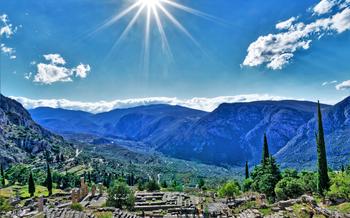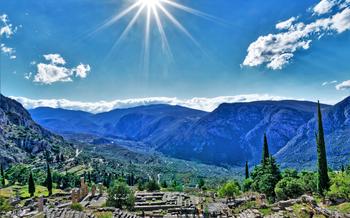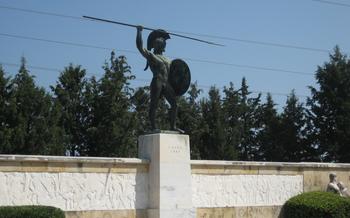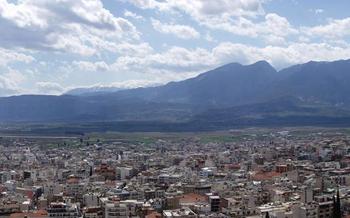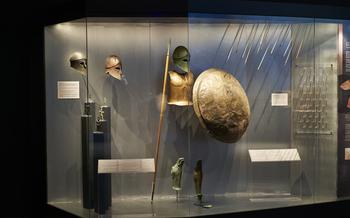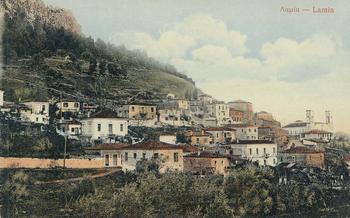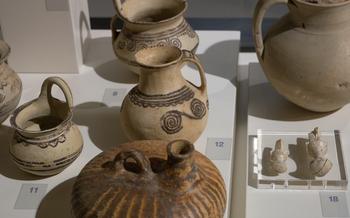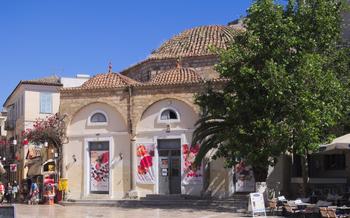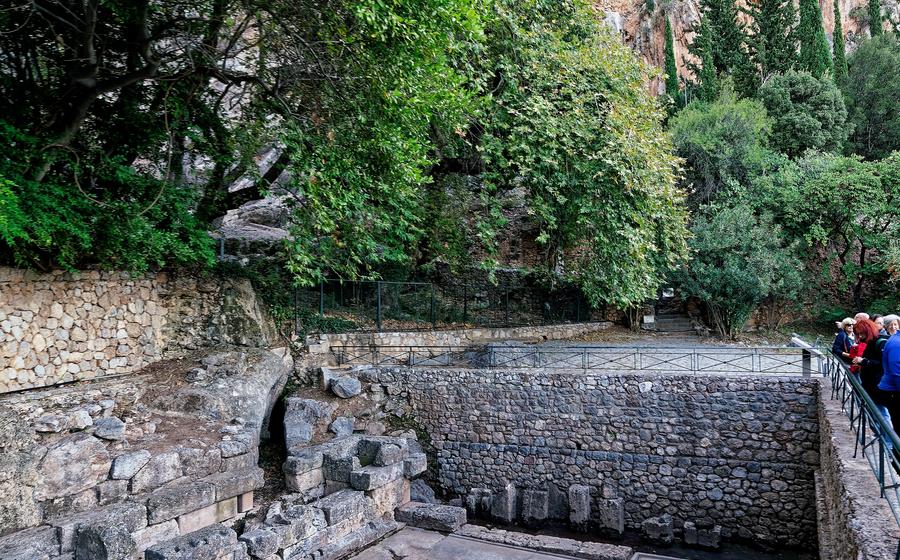
Thermopylae Museum
- A Journey to Thermopylae: Unveiling the Legendary Battlefield
- Delving into the Past: Exploring the Thermopylae Museum
- Honoring the Fallen: The Leonidas Monument
- Thermopylae Hot Springs: A Relaxing Retreat
- Location and Accessibility
- Therapeutic Benefits
- Facilities and Amenities
- Combining History and Relaxation
- Exploring the Ancient City of Thermopylae
- The Battle of Thermopylae: A Historical Overview
- Interactive Exhibits: Bringing History to Life
- The Persian Wars: A Broader Perspective
- Local Cuisine and Hospitality: A Taste of Thermopylae
- Photography Opportunities: Capturing the Essence of Thermopylae
- Educational Programs and Workshops: Learning from the Past
- Souvenirs and Mementos: Preserving Memories of Thermopylae
- Nearby Attractions: Expanding Your Journey
- Insider Tip: Embrace the Local Culture
A Journey to Thermopylae: Unveiling the Legendary Battlefield
In the heart of Greece, where history and legend intertwine, lies Thermopylae, an ancient battlefield etched into the annals of time. This hallowed ground witnessed one of the most heroic and iconic battles in human history, where 300 Spartans, led by their valiant king, Leonidas, stood against an overwhelming Persian army. Immerse yourself in the spirit of Thermopylae, where the echoes of ancient valor still linger, and discover the legacy of courage, sacrifice, and unwavering resolve that continues to inspire generations.
The Battle of Thermopylae, fought in 480 BC, was a pivotal moment in the Greco-Persian Wars. Though outnumbered and outmatched, the Spartans and their allies fought with unwavering determination, holding off the Persian army for three days and nights. Their heroic stand, while ultimately ending in defeat, bought precious time for the Greek city-states to prepare for the impending invasion.
Thermopylae is easily accessible by road, making it a convenient destination for history buffs and travelers alike. The site offers a unique opportunity to walk in the footsteps of ancient warriors and experience the awe-inspiring landscape that shaped one of the most epic battles in human history.
Delving into the Past: Exploring the Thermopylae Museum
The Thermopylae Museum stands as a testament to the rich history and legacy of the legendary battle that took place on these grounds. As you step inside, you'll be greeted by a captivating array of exhibits and displays that transport you back in time. The museum's collection boasts a treasure trove of artifacts and relics, including weapons, armor, pottery, and sculptures that offer a tangible connection to the ancient world.
Interactive exhibits and educational resources bring the history of Thermopylae to life, providing visitors with a deeper understanding of the battle and its significance. Detailed descriptions, maps, and timelines help you visualize the events that unfolded on this fateful battlefield. Guided tours and audio guides are available to enhance your experience, offering expert insights and anecdotes that bring the past vividly to life.
Honoring the Fallen: The Leonidas Monument
Amidst the ruins and remnants of Thermopylae, a solitary figure stands tall, immortalized in bronze - the Leonidas Monument. This majestic statue pays tribute to the legendary king of Sparta, who along with his 300 brave warriors, fought and fell heroically against the overwhelming Persian army in the Battle of Thermopylae.
The monument, towering over the battlefield, exudes an aura of strength, resilience, and defiance. Leonidas, clad in his battle armor, spear in hand, gazes resolutely towards the horizon, embodying the indomitable spirit of the Spartans. The intricate details of the sculpture capture the essence of the warrior king, from the furrowed brow to the determined set of his jaw.
Located near the hot springs, the Leonidas Monument serves as a poignant reminder of the sacrifices made by the Spartans to defend their homeland. Visitors can approach the monument and pay homage to the fallen heroes, reflecting on their bravery and the legacy they left behind.
The monument stands as a testament to the enduring power of courage, sacrifice, and the indomitable will of the human spirit. It invites visitors to remember the Battle of Thermopylae not only as a historical event, but as a timeless tale of heroism and unwavering dedication to one's principles.
Thermopylae Hot Springs: A Relaxing Retreat
After exploring the historical sites of Thermopylae, take a break and rejuvenate at the nearby hot springs. Located just a short distance from the museum and ancient city, these natural hot springs offer a unique and relaxing experience.
Location and Accessibility
The Thermopylae Hot Springs are situated in the picturesque village of Thermopylae, surrounded by lush greenery and stunning mountain views. The hot springs are easily accessible by car or public transportation, making it convenient for visitors to combine history and relaxation in one destination.
Therapeutic Benefits
The hot springs of Thermopylae are renowned for their therapeutic properties. The mineral-rich waters are believed to have healing qualities and can alleviate various ailments, including rheumatism, arthritis, and skin conditions. Visitors can soak in the warm waters and let the soothing minerals work their magic.
Facilities and Amenities
The hot springs complex offers a range of facilities and amenities to ensure a comfortable and enjoyable experience for visitors. There are separate pools for men and women, changing rooms, showers, and lockers. Visitors can also take advantage of the massage services available on-site.
Combining History and Relaxation
A visit to the Thermopylae Hot Springs is an ideal way to unwind and rejuvenate after exploring the historical sites of the area. The combination of history and relaxation makes Thermopylae a unique and memorable destination for travelers seeking a holistic experience.
Exploring the Ancient City of Thermopylae
Unveiling the ruins of the ancient city of Thermopylae offers a glimpse into the daily lives and rich history of its inhabitants. Archaeological excavations have revealed the foundations of houses, temples, and public buildings, providing insights into the urban layout and architecture of the city. Visitors can admire the remains of the ancient theater, where dramas and performances once took place, and explore other notable sites such as the agora, where citizens gathered for trade and political discussions. Walking through the ancient city, one can imagine the hustle and bustle of everyday life in Thermopylae, connecting with the past and gaining a deeper understanding of ancient Greek culture and civilization.
The Battle of Thermopylae: A Historical Overview
The Battle of Thermopylae, fought in 480 BC, stands as a pivotal moment in ancient Greek history. It was a clash between the invading Persian army, led by King Xerxes I, and a small force of Greek city-states, under the command of King Leonidas I of Sparta. Despite their overwhelming numerical disadvantage, the Greeks, comprising 7,000 men, valiantly defended the narrow pass of Thermopylae, holding off the Persian advance for three days.
The battle unfolded in a series of strategic maneuvers and heroic last stands. Leonidas and his 300 Spartans formed the rearguard, sacrificing themselves to allow the rest of the Greek army to retreat. Their legendary stand has become a symbol of courage, honor, and the willingness to fight for freedom against insurmountable odds.
The Battle of Thermopylae, though ultimately a defeat for the Greeks, had a profound impact on the course of the Persian Wars. It demonstrated the resilience and determination of the Greek city-states and inspired them to unite against the Persian threat. The battle also revealed the limitations of the Persian army, particularly their vulnerability to a well-organized and disciplined force.
In the aftermath of Thermopylae, the Greeks regrouped and eventually defeated the Persians at the Battle of Salamis. The victory at Salamis marked a turning point in the war, leading to the eventual expulsion of the Persians from Greece. The Battle of Thermopylae remains a source of national pride for modern Greeks, a testament to the courage and sacrifice of their ancestors.
Interactive Exhibits: Bringing History to Life
The Thermopylae Museum embraces modern technology to make history come alive for visitors of all ages. Through multimedia presentations and interactive displays, the museum offers an immersive experience that enhances the understanding of the Battle of Thermopylae and its significance.
Virtual reality experiences transport visitors to the battlefield, allowing them to witness the battle as if they were there. 3D reconstructions of the ancient city and battlefield provide a visual representation of what Thermopylae looked like in its prime.
Interactive touchscreens offer detailed information about the battle, its participants, and its aftermath. Visitors can explore maps, timelines, and historical documents, gaining a deeper understanding of the events that unfolded.
These interactive exhibits not only make the museum experience more engaging but also contribute to a deeper understanding and appreciation of the history and culture of Thermopylae.
The Persian Wars: A Broader Perspective
The Battle of Thermopylae did not occur in isolation but was part of a larger conflict known as the Persian Wars. These wars, which spanned several decades, were a series of military engagements between the Persian Empire and various Greek city-states.
The causes of the Persian Wars were complex, but the primary catalyst was the growing power and influence of the Persian Empire under King Darius I. Darius sought to expand his empire into Greece, which brought him into direct conflict with the independent Greek city-states.
The Battle of Marathon, which took place in 490 BC, marked the beginning of the Persian Wars. In this battle, the Athenians and their allies defeated the Persian army, preventing their invasion of Greece.
The Battle of Thermopylae, which occurred in 480 BC, was a crucial moment in the Persian Wars. Although the Spartans and their allies were outnumbered, they held off the Persian army for three days, allowing the rest of Greece to prepare for the upcoming invasion.
The Battle of Salamis, which took place in 480 BC, was another decisive victory for the Greeks. In this naval battle, the Greek fleet, led by the Athenian general Themistocles, defeated the Persian fleet, effectively ending the Persian threat to Greece.
The Persian Wars had a profound impact on the course of Greek and Persian history. The Greeks' victory over the Persians ensured their independence and paved the way for the rise of the Athenian Empire. For the Persians, the defeat marked the beginning of a period of decline.
Understanding the broader context of the Persian Wars is essential for appreciating the significance of the Battle of Thermopylae. This battle was not merely a heroic stand against overwhelming odds but a pivotal moment in the history of ancient Greece.
Local Cuisine and Hospitality: A Taste of Thermopylae
Immerse yourself in the culinary delights of Thermopylae, where traditional Greek cuisine takes center stage. Indulge in mouthwatering dishes prepared with fresh, local ingredients, showcasing the region's rich flavors and culinary heritage. Visit traditional tavernas nestled in the heart of the town, where you can savor authentic Greek specialties such as succulent grilled meats, oven-baked casseroles, and an array of fresh seafood. Don't miss the opportunity to try local delicacies like "kleftiko," a slow-cooked lamb dish, or "spetsofai," a spicy sausage and pepper stew. Experience the warmth and hospitality of the local community, who take pride in sharing their culinary traditions with visitors. Engage in lively conversations with the locals, learn about their way of life, and embrace the vibrant atmosphere that defines Thermopylae. Combine history and gastronomy for a truly memorable trip that will tantalize your taste buds and leave you with lasting memories.
Photography Opportunities: Capturing the Essence of Thermopylae
Thermopylae offers a picturesque backdrop for capturing stunning photographs that will immortalize your visit. The battlefield, with its rolling hills and distant mountains, provides a dramatic canvas for showcasing the historical significance of the site. The museum, with its impressive architecture and artifacts, offers ample opportunities for capturing unique and visually appealing shots.
As you explore the ancient city, take advantage of the scenic ruins, ancient theater, and well-preserved structures to create captivating images that transport viewers back in time. Don't miss the chance to photograph the Leonidas Monument, an iconic symbol of courage and sacrifice, against the backdrop of the battlefield.
For the best lighting conditions, plan your visit during the golden hours of sunrise or sunset, when the warm hues cast a magical glow on the landscape. Remember to bring a camera with a wide-angle lens to capture the vastness of the battlefield and a telephoto lens for close-ups of the museum exhibits and ancient ruins.
Share your photographic journey with the world by posting your best shots on social media, using relevant hashtags to connect with other history enthusiasts and fellow travelers. Your images will not only serve as cherished memories but also contribute to promoting the historical and cultural significance of Thermopylae. So, don't forget your camera and capture the essence of this legendary destination through the lens of your creativity!
Educational Programs and Workshops: Learning from the Past
The Thermopylae Museum offers a range of educational programs and workshops, catering to students, history enthusiasts, and lifelong learners. These programs provide an opportunity to delve deeper into the history of Thermopylae and the Battle of Thermopylae, fostering a greater understanding and appreciation of this pivotal event.
Interactive learning experiences and hands-on activities bring the past to life, allowing participants to engage with the museum's exhibits and artifacts in a meaningful way. Workshops may focus on specific aspects of the battle, such as the strategies and tactics employed by both sides, or they may explore the broader context of the Persian Wars and their impact on ancient Greece.
These programs are designed to be both informative and enjoyable, encouraging participants to think critically about the past and its relevance to the present. By fostering a love of learning and a deeper understanding of history, the Thermopylae Museum's educational programs contribute to the preservation and appreciation of this historic site.
Souvenirs and Mementos: Preserving Memories of Thermopylae
The Thermopylae Museum houses a well-stocked gift shop that offers a treasure trove of souvenirs and mementos for visitors to cherish their visit and take a piece of history home with them. Books, replicas, and historical artifacts line the shelves, providing a diverse selection of items to suit every interest.
For bookworms and history buffs, there's an array of publications covering the Battle of Thermopylae, the Persian Wars, and ancient Greek history. These books delve into the details of the conflict, offering insights into the strategies, alliances, and consequences that shaped the course of history.
Replica artifacts, meticulously crafted to resemble their ancient counterparts, make for unique and educational souvenirs. From miniature bronze helmets to intricately designed pottery, these replicas serve as tangible reminders of the ingenuity and artistry of the ancient Greeks.
For those seeking a more immersive experience, the museum shop also offers historical artifacts, such as coins, arrowheads, and pottery shards, that have been unearthed during archaeological excavations at Thermopylae and the surrounding area. These artifacts provide a tangible connection to the past, allowing visitors to hold a piece of history in their hands.
By purchasing souvenirs from the museum shop, visitors not only take home a memento of their visit but also contribute to the preservation of Thermopylae's heritage. The proceeds from the shop support the museum's ongoing efforts to maintain and expand its collection, ensuring that future generations can continue to learn about and appreciate the significance of this legendary battlefield.
Nearby Attractions: Expanding Your Journey
Thermopylae is just one of the many treasures of Greece, and there's plenty more to discover in the surrounding area. For history buffs, the ancient city of Delphi, with its ruins of temples and theaters, is a must-visit. Nature lovers will be enchanted by the breathtaking Meteora monasteries, perched atop towering rock formations. And beach enthusiasts can bask in the sun and swim in the crystal-clear waters of the nearby Gulf of Malia.
With so many attractions within easy reach, you can easily create a comprehensive itinerary that combines history, culture, and natural beauty. Whether you're interested in exploring ancient ruins, hiking through stunning landscapes, or relaxing on pristine beaches, the region surrounding Thermopylae has something for everyone.
Here are some additional nearby attractions to consider:
-
Ancient Corinth: Once a powerful city-state, Corinth is home to impressive archaeological remains, including the Temple of Apollo and the Corinthian Agora.
-
Mycenae: Discover the ancient ruins of Mycenae, the legendary city of King Agamemnon. Explore the Lion Gate, the Treasury of Atreus, and other remnants of this once-great civilization.
-
Epidaurus: Visit the ancient theater of Epidaurus, renowned for its exceptional acoustics. Take a stroll through the Asclepieion, a healing sanctuary dedicated to the god of medicine, Asclepius.
-
Nafplio: Explore the picturesque port town of Nafplio, with its Venetian fortress, charming old town, and scenic waterfront.
-
Monemvasia: Step back in time as you wander through the medieval town of Monemvasia, built on a small island connected to the mainland by a causeway.
Remember to allocate enough time to explore these nearby attractions and make the most of your journey through this fascinating region.
Insider Tip: Embrace the Local Culture
To truly immerse yourself in the spirit of Thermopylae, take the time to engage with the local community. Strike up conversations with the friendly locals, eager to share stories and insights about their beloved homeland. Learn about their customs, traditions, and way of life, which have been shaped by centuries of history. Participate in traditional festivals and events, where you can experience the vibrant culture firsthand. Support local businesses and artisans by shopping at their stores and sampling their delicious culinary creations. Embrace the opportunity to connect with the people of Thermopylae, whose warm hospitality and rich cultural heritage will leave a lasting impression.
